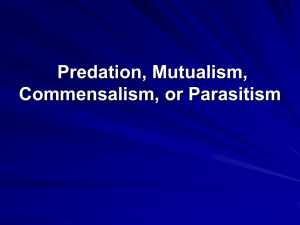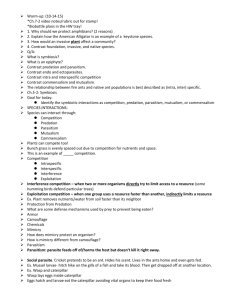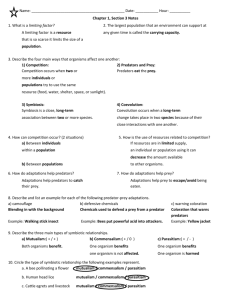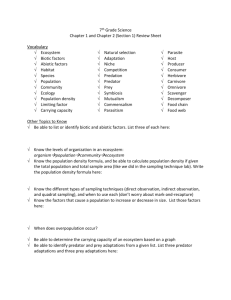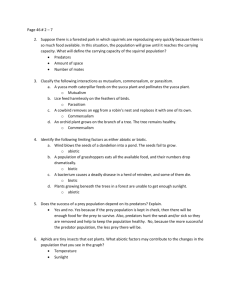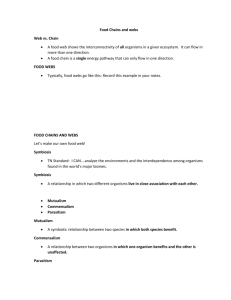Community Ecology Chapter 27 study guide
advertisement
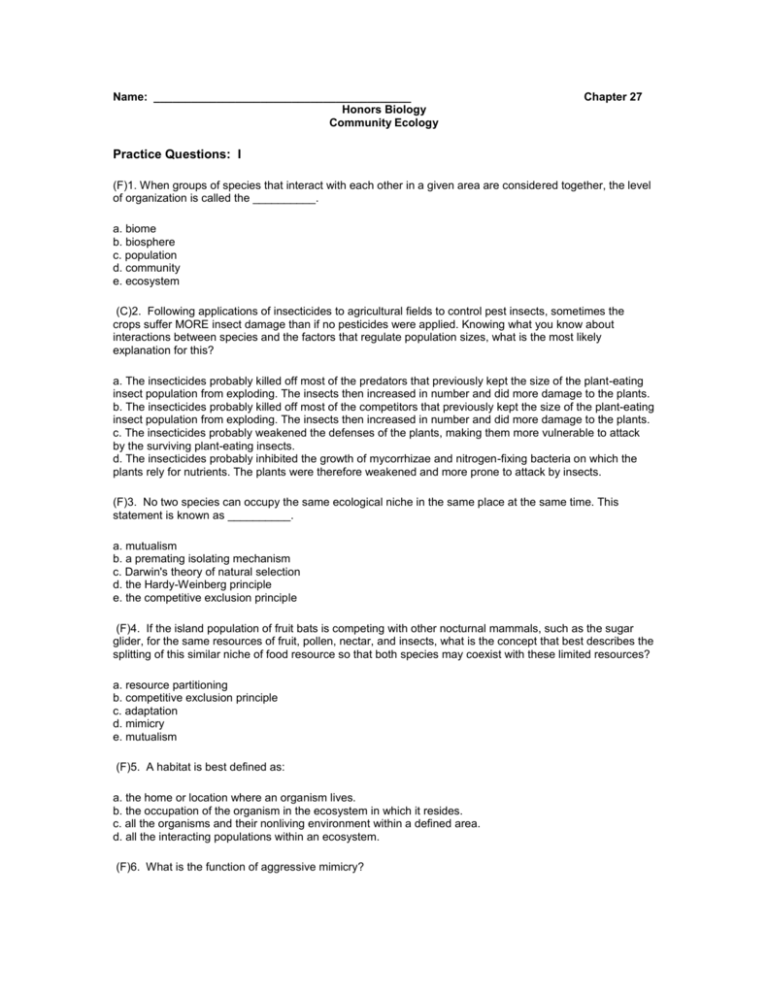
Name: _________________________________________ Honors Biology Community Ecology Chapter 27 Practice Questions: I (F)1. When groups of species that interact with each other in a given area are considered together, the level of organization is called the __________. a. biome b. biosphere c. population d. community e. ecosystem (C)2. Following applications of insecticides to agricultural fields to control pest insects, sometimes the crops suffer MORE insect damage than if no pesticides were applied. Knowing what you know about interactions between species and the factors that regulate population sizes, what is the most likely explanation for this? a. The insecticides probably killed off most of the predators that previously kept the size of the plant-eating insect population from exploding. The insects then increased in number and did more damage to the plants. b. The insecticides probably killed off most of the competitors that previously kept the size of the plant-eating insect population from exploding. The insects then increased in number and did more damage to the plants. c. The insecticides probably weakened the defenses of the plants, making them more vulnerable to attack by the surviving plant-eating insects. d. The insecticides probably inhibited the growth of mycorrhizae and nitrogen-fixing bacteria on which the plants rely for nutrients. The plants were therefore weakened and more prone to attack by insects. (F)3. No two species can occupy the same ecological niche in the same place at the same time. This statement is known as __________. a. mutualism b. a premating isolating mechanism c. Darwin's theory of natural selection d. the Hardy-Weinberg principle e. the competitive exclusion principle (F)4. If the island population of fruit bats is competing with other nocturnal mammals, such as the sugar glider, for the same resources of fruit, pollen, nectar, and insects, what is the concept that best describes the splitting of this similar niche of food resource so that both species may coexist with these limited resources? a. resource partitioning b. competitive exclusion principle c. adaptation d. mimicry e. mutualism (F)5. A habitat is best defined as: a. the home or location where an organism lives. b. the occupation of the organism in the ecosystem in which it resides. c. all the organisms and their nonliving environment within a defined area. d. all the interacting populations within an ecosystem. (F)6. What is the function of aggressive mimicry? a. to hide a prey from a predator b. to warn a predator that a prey is dangerous c. to warn a predator that a prey is distasteful d. to keep prey from recognizing a predator e. to startle a prey when it sees a predator (C)7. The rattles of rattlesnakes would be similar in function to which of the following? a. camouflage b. warning coloration c. startle coloration d. aggressive mimicry e. Both the second and third answers are correct. (F)8. The close interaction between organisms of different species over an extended period of time, in which one individual benefits while the other individual neither benefits nor is harmed by the relationship, is known as ___________. a. predation b. competition c. parasitism d. mutualism e. commensalism (C)9. Honeyguides are African birds that excitedly lead the way to a bee’s nest, and ratels are the honeyand bee-eating mammals that open up and scatter the contents of the bee’s nests, allowing both the ratels and the honeyguides to feed on the contents. This relationship is an example of __________. a. predation b. competition c. parasitism d. mutualism e. commensalism (C)10. Trypanosoma is a protozoan (single-celled organism) that lives and reproduces for an extended period in the blood of a mammalian host (e.g., a human, native antelope, or introduced cattle). Newly introduced cattle generally die from this infection if they are not treated, whereas the native antelope, or cattle that have been exposed to this protozoan for several generations, are less severely affected. This relationship is an example of __________. a. predation b. competition c. parasitism d. mutualism e. commensalism (C)11. The beaver, Castor canadensis, seldom reaches densities anywhere near those achieved by most other rodents. However, its effect on ecosystems can be enormous. By damming streams it creates ponds and wetlands. This can kill trees in the midst of an otherwise continuous stand of climax forest, making room for many aquatic and semiaquatic species. When the beaver move on and the pond fills in, the meadow left behind also represents a new and different habitat type suitable for yet other species. In short, the beaver can dramatically increase the complexity of ecosystems, leaving behind a mosaic of habitat types that supports enormous biodiversity. It is clear from this description that the beaver is __________ in the forest ecosystem. a. a keystone species b. a pioneer species c. a climax species d. a dominant species (C)12. In the intertidal zone, diverse assemblages of many invertebrate species and algae exist attached to the rocks. If an oil spill occurred that directly affected only a species of starfish that is a keystone predator in this system, totally eliminating it, what do you predict would happen to the community? a. No significant change in the structure of the community would be likely to occur. b. The community is likely to become less diverse, increasingly dominated by a few species that are good competitors for space. c. The community is likely to become more diverse, as strong and weak competitors can then coexist. (C)13. Why does a climax community tend to persist in an area? a. because it is made up of large, hard-to-move organisms b. because the species in it do not alter their environment significantly c. because it is able to change the weather d. because the species in it are able to kill off competitors (C)14. Boulders are often overturned by wave action during storms along the lower reaches of the rocky intertidal shore. Along the coast of Southern California, there is a fairly predictable sequence of species that colonize the bare rock as spores and then replace each other. This starts with the green algae Ulva, which is replaced after a year or so by various red algae and so on. This is an example of __________. a. primary succession b. secondary succession c. aggressive mimicry d. a keystone species (F)15. The structural change in a community and the abiotic environment over time, in which assemblages of plants and animals replace one another in a relatively predictable sequence, is called ___________. a. evolution b. radiation c. selection d. succession e. symbiosis Practice Questions: II (C)1. Why are community interactions so important? a. Interspecies interactions affect the ability of species to survive and reproduce. b. Coevolution has shaped the behaviors and form of interacting species. c. All of the above d. None of the above (C)2. Corals are polyps of coelenterates (cnidarians) that contain numerous algae in their tissues. The algae contain photopigments which give the corals their color. When stressed by high temperatures, water pollution, or similar shocks, many corals expel their algae and turn white, a process called "coral bleaching." This appears to help the coelenterates survive the initial shock, but if they do not recover their native algae quickly, they soon die. Similarly, the algae cannot live for long outside of the coelenterates' bodies. Based on this information, the relationship between the two organisms is most likely __________. a. a mutualism b. interspecific competition c. a commensalism d. a parasitism e. a predation (C)3. In a farm pond location a landowner decided to introduce bluegill Lepomis macrochirus because she liked to fish and preferred to eat the bluegill species. The species of fish already living in the pond were sunfish Lepomis humilis. After introduction of the bluegill, which is very similar to sunfish in habitat and food preferences, the landowner discovered several years later that there were not as many sunfish in the pond; the sunfish numbers had diminished over time. This is an example of: a. intraspecific competition. b. interspecific competition. c. competitive exclusion principle. d. Both A and C are correct. e. Both B and C are correct. (C)4. What were the differences in the niches of the Paramecium in Gause’s second experiment that allowed them to coexist? a. food eaten b. body size c. feeding area d. preferred water temperature e. preferred pH (C)5. Within a year of abandoning agriculture on a plot of prairie, the previously bare soil is overrun with annual weeds. Light, carbon dioxide, and mineral nutrients are readily available, but soil moisture is limiting. Still, some species appear to coexist very close to one another. Upon closer examination, two such species, smartweed and bristly foxglove, are observed to have very different root systems and ways of managing water. Smartweed has a very deep taproot, extending about a meter beneath the surface, tapping (literally) into a continuous deep water supply. Bristly foxtail has a much shallower and spreading fibrous root system, reaching less than 20 cm down. However, the latter plant is able to tolerate periods of drought and rapidly take up water after a rain. This example is a clear case of __________. a. resource partitioning b. competitive exclusion c. intraspecific competition d. commensalism e. a keystone species (F)6. A poisonous frog with bright and colorful body markings is an example of __________. a. camouflage b. mimicry c. warning coloration d. aggressive mimicry (C)7. Fireflies use their amazing bioluminescence to find mates of the right species. Males fly around and emit a series of flashes in a pattern that differs from all other species. A female, perched nearby, may respond with her own species-specific signal. The male immediately flies towards her and, after a few more exchanges, it's wedded bliss! Well, not always. Females of a few species have learned to imitate other species' signals and, when their males arrive, they eat them. These femme fatales are exhibiting a form of __________. a. aggressive mimicry b. startle coloration c. camouflage d. warning coloration e. chemical warfare (C)8. In many ways, parasitism and predation are very similar types of interactions between species. Which of the following is NOT true about their differences? a. Parasites are usually much smaller than their hosts, but predators are usually larger than their prey. b. Parasites are usually much more numerous than their hosts, but predators are usually less numerous than their prey. c. Parasites usually don't immediately kill their hosts, but predators do usually immediately kill their prey. d. Parasites usually have no effect on their hosts, but predators usually harm their prey. (C)9. On many coral reefs in the Pacific, large fish bearing parasites will visit "cleaning stations" where species of small fish, known as cleaner wrasses, remove parasites and loose scales from the larger fish. The cleaner fish may even enter the mouth and gills of the larger fish to clean parasites from the soft tissues. The cleaner fish are recognized by their coloration, black with a bright blue or yellow stripe, and by a little "dance" that invites the larger fish in to be cleaned. Also on the reef, however, is a small fish known as the saber-tooth blenny. Looking and acting very much like the cleaner wrasse, the blenny also attracts the larger fish, but instead of cleaning away parasites, the blenny bites small bits of flesh from the larger fish. The interactions among the larger fish, the cleaner wrasse, and the saber-tooth blenny represent all but which of the following? a. mutualism b. parasitism c. aggressive mimicry d. warning coloration (F)10. What is the term for a situation in which one organism benefits from its close association with a second species, but the second species is harmed in the process? a. commensalism b. mutualism c. parasitism d. Both of the first two answers are correct. (C)11. In the rocky intertidal zone, along the coast of the state of Washington, space on the substrate (rocks) is a critical resource for sessile (attached) organisms, such as algae, barnacles, and mussels, and also for other organisms that graze the algae or prey on the sessile animals. For example, limpets graze the algae, and three species of barnacle dominate the algae for space. Among them they form a dominance hierarchy, with the larger Semibalanus dominating Balanus, which in turn dominates the smaller Chthamalus. The mussel, Mytilus, is at the top of this hierarchy. A large thaid snail feeds on Balanus and Chthamalus but cannot take the larger Semibalanus or the mussel. The starfish, Pisaster, however, prefers to feed on mussels and the large barnacle Semibalanus. Thus, if the starfish is present in this community, the community will be a diverse assemblage of nearly all of the species described here; but if the starfish is absent, the dominant mussel will take over most of the available space. In this example we see __________. a. predation b. intraspecific competition c. interspecific competition d. a keystone species e. all of the above (F)12. What is a "keystone species?" a. any species that is found in the state of Pennsylvania b. a species that plays a key role in determining community structure that is greater than its abundance alone would predict c. a type of symbiosis between two species in which one species lives inside another d. any species that plays a important role in the community e. none of the above (F)13. Plants and animals invade a region recently scoured clean by a retreating glacier and over time are replaced by other species. This statement describes __________. a. a climax community b. primary succession c. secondary succession d. all of the above (F)14. When all vegetation is removed from a site by human activities or by natural forces such as volcanoes or glaciers, _______ species are the first to colonize the sites. a. Archaea b. pioneer c. climax d. latent (C)15. Organisms in a succession community help to cause the changes that result in their own replacement because: a. they become old and unfit for the environment. b. they change the physical environment in ways that favor competitors. c. they emigrate to other areas to make room for new species.
